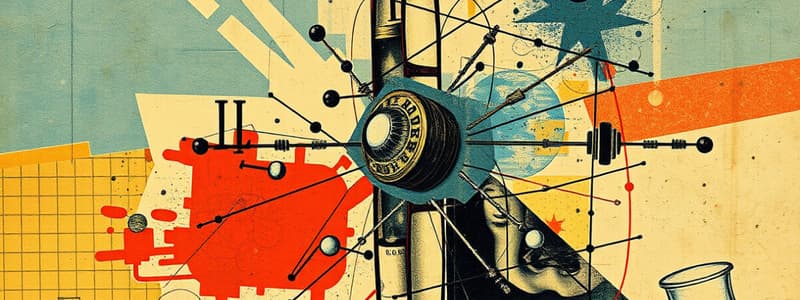Podcast
Questions and Answers
Which of the following is correct regarding elements? (Select all that apply)
Which of the following is correct regarding elements? (Select all that apply)
- An element is composed of many different molecules.
- All atoms of an element will have the same atomic number. (correct)
- Elements are organized alphabetically on the periodic table.
- Matter on earth is composed of 24 naturally occurring elements.
Which of the following elements is NOT found in the substance Ca(H2PO4)2?
Which of the following elements is NOT found in the substance Ca(H2PO4)2?
- Calcium
- Hydrogen
- Potassium (correct)
- Oxygen
Which statement is incorrect regarding the element barium?
Which statement is incorrect regarding the element barium?
- The symbol for the element barium is Ba.
- The element barium will have chemical properties similar to calcium.
- The element barium has an atomic mass of 56. (correct)
- The element barium has an atomic number of 56.
_____ contributes to both the atomic number and the atomic mass.
_____ contributes to both the atomic number and the atomic mass.
The 11 electrons in an atom of sodium:
The 11 electrons in an atom of sodium:
Which statement applies to the subatomic particle that has a positive charge?
Which statement applies to the subatomic particle that has a positive charge?
The valence shell of an atom:
The valence shell of an atom:
If an unidentified atom 'X' were to lose two electrons, it would...
If an unidentified atom 'X' were to lose two electrons, it would...
131I is often used by clinicians to specifically study the activity of the thyroid gland. This isotope is useful because it is...
131I is often used by clinicians to specifically study the activity of the thyroid gland. This isotope is useful because it is...
Which of the following combinations of subatomic particles would be an example of an isotope of carbon?
Which of the following combinations of subatomic particles would be an example of an isotope of carbon?
Calcium atoms have 20 protons. How many electrons does a neutral atom of calcium have?
Calcium atoms have 20 protons. How many electrons does a neutral atom of calcium have?
Which of the following subatomic particles is present in the same number in all atoms of a particular element?
Which of the following subatomic particles is present in the same number in all atoms of a particular element?
If an atom of fluorine has 15 protons, 16 neutrons, and 15 electrons, its atomic mass is ____.
If an atom of fluorine has 15 protons, 16 neutrons, and 15 electrons, its atomic mass is ____.
What type of bond is formed BETWEEN two water molecules?
What type of bond is formed BETWEEN two water molecules?
Ionic bonds form when...
Ionic bonds form when...
Ammonia has the chemical formula NH3. What type of bonds are formed between the nitrogen atom and the hydrogen atoms in ammonia?
Ammonia has the chemical formula NH3. What type of bonds are formed between the nitrogen atom and the hydrogen atoms in ammonia?
Methane has the chemical formula CH4. What type of bonds are formed between the carbon atom and the hydrogen atoms?
Methane has the chemical formula CH4. What type of bonds are formed between the carbon atom and the hydrogen atoms?
Bonds which are formed when two atoms share their electrons unequally are called...
Bonds which are formed when two atoms share their electrons unequally are called...
In the equation 2 H2 + O2 → 2 H2O,
In the equation 2 H2 + O2 → 2 H2O,
If you INCREASE the volume of a gas, what happens to the pressure of the gas?
If you INCREASE the volume of a gas, what happens to the pressure of the gas?
What is the fundamental difference between covalent and ionic bonding?
What is the fundamental difference between covalent and ionic bonding?
Which of the following best describes the atomic number of an atom?
Which of the following best describes the atomic number of an atom?
Flashcards are hidden until you start studying
Study Notes
Elements and Atoms
- An element consists of atoms that share the same atomic number.
- Matter on Earth is composed of 24 naturally occurring elements.
- Ca(H2PO4)2 is found in bones; potassium is not a component of this substance.
- Barium has the symbol Ba and an atomic number of 56; the incorrect statement is that it has an atomic mass of 56.
Subatomic Particles
- Protons contribute to both atomic number and atomic mass.
- Electrons in sodium move around the nucleus; those with more energy are located farther from the nucleus.
- A positively charged subatomic particle has a mass of 1 amu.
- In any element, all atoms contain the same number of protons.
Isotopes and Atomic Mass
- An atom "X" losing two electrons will result in a net charge of +2 and increased instability.
- Example of an isotope of carbon: 6 protons, 8 neutrons, 6 electrons leads to an atomic mass of 14.
- Fluorine's atomic mass, with 15 protons, 16 neutrons, and 15 electrons, totals to 31.
Bonding
- The valence (outermost) shell contains electrons necessary for bonding.
- Polar covalent bonds occur between water molecules and in compounds like ammonia (NH3) and methane (CH4).
- Ionic bonds form when one atom donates and another gains electrons.
- Bonds that share electrons unequally are known as polar covalent bonds.
Chemical Reactions and Properties
- In the reaction 2 H2 + O2 → 2 H2O, H2O is recognized as a compound.
- Increasing the volume of a gas results in a decrease in pressure.
- The primary difference between covalent and ionic bonding lies in electron sharing versus electron transfer.
Studying That Suits You
Use AI to generate personalized quizzes and flashcards to suit your learning preferences.




